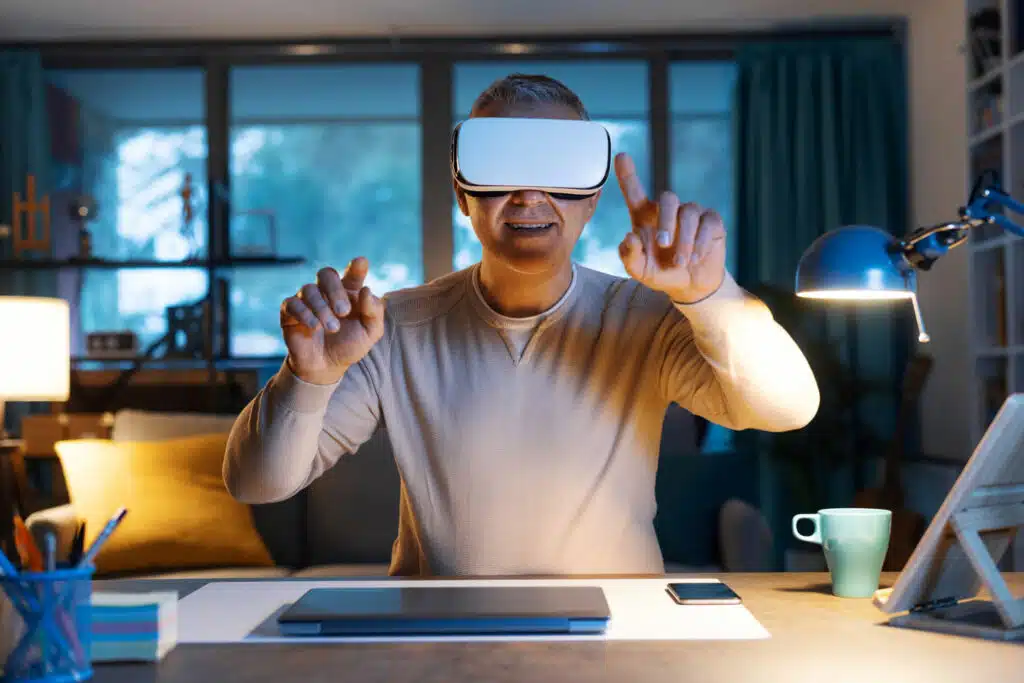As the digital landscape evolves, businesses must adapt to emerging technologies to stay ahead. One such technology that holds immense potential is spatial computing (SC), especially now with the recent launch of the Apple Vision Pro. Spatial computing (SC) integrates the physical and digital worlds, offering immersive and interactive experiences. In this blog post, we will explore how business websites can prepare for the advent of spatial computing (SC). By embracing this technology, businesses can enhance user experiences, engage visitors in new ways, and create a competitive edge in the digital realm.

Embracing Responsive and Scalable Design
Spatial computing introduces a new dimension to web design. Business websites should focus on adopting responsive and scalable designs that can seamlessly adapt to various SC devices and screen sizes. Ensuring that the website’s layout, images, and content are optimised for both traditional screens and SC platforms will be crucial. By implementing responsive design principles, businesses can deliver consistent and engaging experiences across different devices and capture the attention of SC users.
Implementing Immersive Content
Spatial computing offers exciting possibilities for immersive content on business websites. By integrating augmented reality (AR) and virtual reality (VR) elements, businesses can provide interactive experiences that captivate visitors. For example, product visualisation in 3D, allows customers to virtually try on products or interactive virtual showrooms. These immersive experiences can help businesses showcase their products or services in a compelling and memorable way, leading to increased engagement and conversion rates.

Optimising for Voice and Gesture Controls
As we delve further into the transformative realm of spatial computing (SC), it becomes increasingly apparent that businesses must strategically optimise their websites to align with the unique demands of this cutting-edge technology. Spatial computing, notably reliant on gesture and voice controls, necessitates a paradigm shift in web design strategies. To cater to the evolving expectations of users engaging with SC devices like augmented reality glasses or virtual reality headsets, businesses should consider a comprehensive approach to website optimisation.
One crucial aspect is the integration of voice search functionality, allowing users to interact with the website effortlessly through spoken commands. By incorporating advanced voice recognition systems, businesses can not only enhance user convenience but also tap into the immersive potential of spatial computing.
Additionally, intuitive gestures play a pivotal role in the SC interface, and websites should incorporate responsive design elements that seamlessly respond to these gestures. This may involve refining navigation elements to align with the gestural language of spatial computing, ensuring a fluid and intuitive user experience.
Furthermore, the accessibility of website content and functionality through voice commands and gestures becomes paramount in engaging SC users effectively. Businesses should prioritise the development of interfaces that not only recognise diverse voice commands but also interpret gestures accurately. This can involve leveraging sophisticated algorithms and technologies that enable precise gesture recognition, providing users with a natural and seamless interaction with the website’s features.
In this era of spatial computing, where user engagement is redefined through innovative interfaces, the optimisation journey goes beyond mere adaptability; it embraces a proactive approach to cater to the preferences and behaviours of spatial computing users.
As businesses venture into this transformative landscape, ensuring that their websites are not only technically compatible with voice and gesture controls but also thoughtfully designed to offer a user-friendly, immersive experience becomes an integral part of their strategic digital initiatives. Embracing these advancements in website optimisation is not just a response to a technological shift; it’s a strategic investment in staying at the forefront of user experience innovation in the spatial computing era.
Ensuring Seamless Integration with Spatial Computing Platforms
To prepare for spatial computing, business websites should aim for seamless integration with SC platforms. This may involve utilising SC software development kits (SDKs), working with SC technology providers and an SC-ready professional website design agency. By integrating their websites with these platforms, businesses can leverage the unique features and capabilities of SC devices, providing users with enhanced experiences. Ensuring compatibility with platforms such as augmented reality glasses or virtual reality headsets will help businesses stay at the forefront of SC advancements.
Spatial computing is reshaping the digital landscape, presenting exciting opportunities for businesses. By preparing their websites for SC, businesses can create immersive experiences, engage users in new ways, and gain a competitive advantage. Embracing responsive design, implementing immersive content, optimising for voice and gesture controls, and ensuring seamless integration with SC platforms are key steps in future-proofing business websites for the SC era.
Conclusion to Spatial Computing
In conclusion, as businesses navigate the evolving digital landscape, adapting to emerging technologies becomes imperative for staying ahead. The recent launch of the Apple Vision Pro has underscored the potential of spatial computing (SC) as a transformative force. Spatial computing seamlessly integrates the physical and digital realms, offering immersive experiences that hold tremendous promise.
This blog post has explored how business websites can prepare for the advent of spatial computing, emphasising the need to embrace responsive and scalable designs, implement immersive content strategies, optimise for voice and gesture controls, and ensure seamless integration with spatial computing platforms.By taking these steps, businesses can enhance user experiences, captivate visitors with interactive content, and establish a competitive edge in the digital realm, effectively future-proofing their online presence for the spatial computing era.



